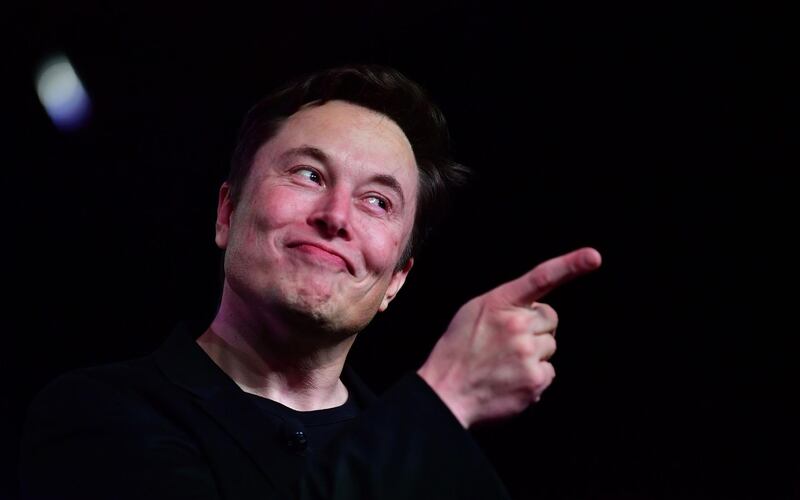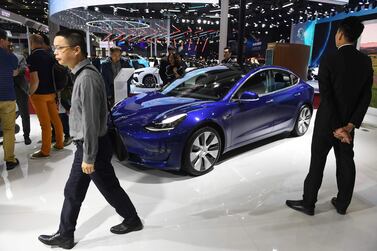Steve Jobs was said to operate his own “reality distortion field”, persuading others to believe in the seemingly impossible.
Tesla’s CEO, Elon Musk, has tapped into similar powers. But on Monday, when he hosted his company’s autonomy demonstration, reality remained stubbornly intact.
Mr Musk, along with several senior managers, spent hours showcasing an area of technology, autonomous driving, where Tesla doesn’t enjoy quite the same pioneering reputation it has in vehicle electrification. Certainly, the first presentation – Peter Bannon, vice president of silicon engineering, on the company’s “full self-driving,” or FSD, computer – seemed squarely aimed at establishing Tesla’s technical bona fides, even if it sometimes ran the risk of leaving non-geeks somewhat bewildered (sample line: “In this network, of the 35 billion operations, almost all of them are Convolution, which is based on dot product; the rest are Deconvolution, also based on dot product; and then ReLu and Pooling, which are relatively simple operations.")
But the longer things wore on, the less credible it seemed. Bold claim followed bold claim. Lidar, the sensor technology favoured by most other developers of autonomous vehicles, was declared “lame”, with Mr Musk predicting his rivals would eventually wake up and ditch it or be “doomed”. Could he be right? Perhaps. But it’s a big ask to have us accept that everyone else working on this is just being stupid when Tesla has spent the past year or so struggling with the process of manufacturing and delivering cars.
The most interesting claims concerned robotaxis. The idea of Tesla owners being able to send their prized vehicles hither and yon autonomously to earn money offering rides has been around for a few years. Now Mr Musk says there will be a million potential Tesla robotaxis on the road sometime in 2020, just waiting for a software update that will unleash their earning power, perhaps $30,000 apiece in annual gross profits.
I may well be lame, but I wonder if there really will be a million autonomous Teslas each earning an average gross margin of $30,000 as they ply the streets for business next year or maybe even the year after that. This is partly because, as Mr Musk acknowledged himself on Monday, his guidance can be a little off when it comes to timing. Back in October 2016, Tesla boasted in a blog post that “All Tesla Cars Being Produced Now Have Full Self-Driving Hardware”, which was essentially also the message from Monday’s show-and-tell.
I don’t appear to be alone either. Because if the market really bought the idea that Tesla had essentially mastered full self-driving almost to the point where a vehicle costing less than $40,000 had a net present value of, as Mr Musk said, $200,000 due to its earnings power, there is no way Tesla’s stock would have gone down and stayed down on Monday.
Possibly, like me, investors were puzzled at the very idea of discounting a theoretical gross margin to come up with a net present value (a bit like looking at your pre-tax wages and shouting “woo-hoo!” Homer Simpson-style). They may also have wondered why a company would even sell a vehicle supposedly worth north of $200,000 for less than $40,000 in the first place, rather than just keeping it and running it themselves.
There was more. Asked how much money Tesla was spending on autonomous technology, Mr Musk said it was essentially “the entire cost structure”. That’s just odd when you consider Tesla definitely spends money on production lines for existing vehicles, along with retail operations and its solar and battery businesses – and has been trying to slash those costs to the bone.
Asked about financing, Mr Musk indicated Tesla would be roughly cash-flow neutral while it was building out its autonomous fleet “around the world”, before becoming strongly cash-flow positive. What exactly “cash-flow neutral/positive” means at this point is up for debate. But only last October, Mr Musk suggested Tesla could be “positive cash flow” in all quarters apart from those, like the last one, where it was repaying debt. Has that now been deferred until after the robofleet has been deployed in numbers in, ahem, 2020?
As of Tuesday morning’s pre-game, Tesla’s stock had slipped below $260, a level that has formed something of a floor for much of the past two years. Like the shrug that greeted the Model Y’s unveiling last month, this ambivalence in the face of apparently game-changing technology should trouble Tesla bulls.
To be clear, at 125 times estimated adjusted earnings for 2019, the stock is still priced for a jet-pack future. The halo effect of past achievements, such as the Model S, remains and there can be little doubt that Tesla’s products have loyal fans. But maybe too much has happened in the past year, from fanciful takeover deals to u-turn strategic shifts to a sudden drop in demand, for yet another declaration of intent to engender an instant rally. Real numbers, in the form of what are almost certainly bad first-quarter results, are imminent.
Try to distort reality too much, and eventually you merely reinforce it.
Bloomberg







